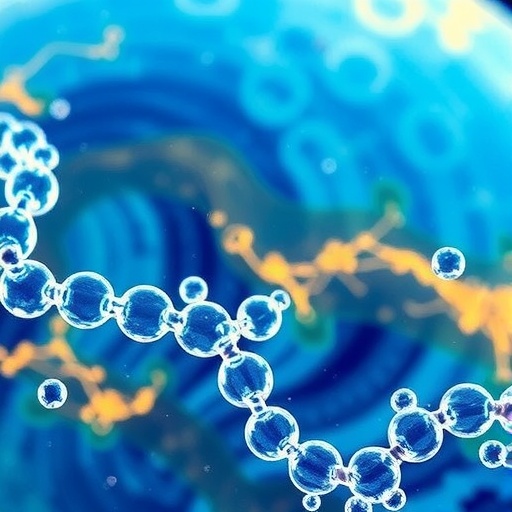In a groundbreaking study published in Nature Communications, researchers have unveiled a transformative pathway that elucidates the dominant formation of organosulfates in the marine atmosphere. This discovery centers on spontaneous oxidation processes occurring specifically at the surface of atmospheric aerosol droplets. The findings challenge longstanding assumptions about the chemical mechanisms underlying organosulfate generation, thereby providing novel insights into marine atmospheric chemistry and its broader implications for climate and air quality.
Organosulfates are a pivotal class of organic compounds found ubiquitously in the atmosphere. They originate from the oxidation of volatile organic compounds (VOCs) and play a critical role in secondary organic aerosol (SOA) formation. SOAs influence cloud properties, atmospheric radiative balance, and human health through their ability to scatter sunlight and serve as cloud condensation nuclei. Despite their importance, the precise chemical pathways responsible for organosulfate formation have remained elusive, particularly in marine environments where the chemical milieu is uniquely complex.
The innovative research conducted by Du, Song, Li, and colleagues reveals that the surface of aerosol droplets acts as an active chemical microenvironment that significantly accelerates organosulfate production. Utilizing advanced spectroscopic techniques combined with molecular modeling, they demonstrate that spontaneous oxidation reactions begin at the droplet-air interface. This oxidation occurs without external light or radical initiators, indicating an intrinsic property of the droplet surfaces that facilitates organosulfate synthesis.
This spontaneous surface oxidation mechanism overturns previous hypotheses that primarily attributed organosulfate formation to photochemical reactions driven by hydroxyl radicals or other free radicals in the gas phase. Instead, the study positions droplet surfaces as catalytic platforms. The interface’s unique chemical milieu, marked by high concentrations of sulfates, organic precursors, and moisture, allows for highly localized electron transfer reactions. Such reactions yield organosulfates at rates and scales previously unaccounted for in atmospheric models.
The researchers employed a suite of cutting-edge analytical tools, including liquid chromatography coupled with mass spectrometry and surface-sensitive spectroscopic methods, to quantify and characterize organosulfate species generated. Their findings highlight a substantial enrichment of organosulfates on the droplet surface compared to the bulk phase, underscoring the critical role of interfacial chemistry. Computational simulations corroborated these experimental results by depicting feasible reaction pathways and energy profiles consistent with spontaneous oxidation.
Importantly, this discovery carries profound implications for marine atmospheric chemistry, considering that oceans cover over 70% of the Earth’s surface and emit vast quantities of organic precursors. Organosulfates formed via this dominant pathway contribute to the marine aerosol load, thus influencing cloud formation and albedo effects on a global scale. The enhanced aerosol-cloud interactions stemming from these organosulfates could induce feedback mechanisms affecting atmospheric circulation and climate processes.
This novel understanding also extends its influence to the field of atmospheric modeling. Current models often underestimate the production rates of organosulfates due to the omission or underrepresentation of droplet surface reactions. Incorporating this spontaneous oxidation pathway could dramatically refine predictive capabilities regarding aerosol evolution, cloud microphysics, and the atmospheric lifetimes of organic compounds.
Moreover, this work indirectly informs studies related to air pollution and human health. Marine aerosols can be transported inland, where organosulfates contribute to particulate matter affecting respiratory and cardiovascular health. By pinpointing the mechanisms of their formation, mitigation strategies can be developed more effectively to assess and manage air quality in coastal regions.
The study also opens avenues for further research probing the intricacies of interfacial chemistry within atmospheric droplets. Questions regarding which specific organic species and sulfate configurations optimize or hinder spontaneous oxidation remain fertile ground for exploration. Additionally, the potential influence of environmental parameters such as temperature, humidity, and ionic strength will be crucial in contextualizing these findings within diverse atmospheric settings.
Beyond marine contexts, this mechanism could have analogs in continental and urban environments, where aerosol droplets interact with complex mixtures of organic and inorganic species. Understanding whether spontaneous oxidation at droplet surfaces is a ubiquitous atmospheric process could revolutionize the broader field of aerosol chemistry.
The interdisciplinary nature of this research highlights the importance of integrating physical chemistry, atmospheric science, and environmental engineering to solve pressing challenges in climate and air quality science. As analytical and computational technologies evolve, studies like this illuminate the microscopic processes that collectively shape global atmospheric phenomena.
Ultimately, the revelation of droplet surface spontaneous oxidation as a dominant organosulfate formation pathway represents a paradigm shift in atmospheric chemistry. This insight underscores the subtle yet profound influence of droplet interfaces in driving chemical transformations that resonate across environmental and climatic systems. It calls for a reevaluation of traditional chemical models and promotes a nuanced appreciation of the marine atmosphere’s complexity.
In summary, the work by Du and colleagues advances our comprehension of marine aerosol chemistry and heralds pivotal advancements in modeling and environmental science. Their findings underscore droplet surfaces as dynamic, chemically active sites fostering spontaneous organosulfate formation, a process with far-reaching implications for climate, air pollution, and human health. As this emerging perspective gains traction, it will undoubtedly inspire further research and innovation within the atmospheric sciences community.
Subject of Research: Formation pathways of organosulfates in the marine atmosphere via spontaneous oxidation at aerosol droplet surfaces.
Article Title: Droplet surface spontaneous oxidation as a dominant formation pathway of organosulfates in the marine atmosphere.
Article References:
Du, L., Song, Y., Li, J. et al. Droplet surface spontaneous oxidation as a dominant formation pathway of organosulfates in the marine atmosphere. Nat Commun 16, 10146 (2025). https://doi.org/10.1038/s41467-025-65008-3
Image Credits: AI Generated




